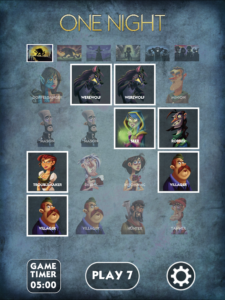Game: One Night Werewolf
Creator: Bezier
Platform: Mobile app and cards
The target audience seems to be for people anywhere in the age range of 13 to 60. The rules are not incredibly difficult to follow along, and there are only a set number of roles which reduces the complexity.
We played with 4 players, but I believe there can be anywhere between 3 – 10 players. One Night Werewolf doesn’t require that the players know each other as well.
Everyone is given a role card, and the extra cards remain in the center. Everyone then closes their eyes for the night, and when it is their role’s turn, they perform the action of their role (ex. troublemaker can switch two cards, werewolves can take a look at a card in the middle, seer can take a look at someone’s card, robber can switch their card with someone else’s). At the end of the night, everyone wakes up. The objective now is to discuss your roles and figure out who the werewolves are (if there are any to begin with), and vote them out. The actions that are granted to you by your role act as resources for information about the group, and the outcome is either a tie, the villagers win, the werewolves win, or the game wins. Because of these outcomes, the game could be classified as a mix between multilateral competition and multiple individuals versus the game. In terms of physical resources for the game, it requires role cards and the mobile app which narrates the game and procedures. It can be played wherever, as long as there is access to these resources.
The game instantly reminds me of Mafia. There are two main sides: the Mafia and the villagers. The group tries to collectively figure out and vote out the Mafia, while the Mafia try to kill off the villagers. There are also special roles that aid with discovering who the Mafia is. While they are similar, there are some key differences between One Night Werewolf and Mafia. For one, there is only one round in One Night Werewolf. Because of this, the special roles in ONW seem to provide more valuable information about the team per turn, since there is only one night to discuss. Additionally, they differ in the outcomes. In Mafia, there are only two outcomes: the Mafia wins or the villagers win. In ONW, however, as mentioned earlier, there is competition between the players and the game itself, since we are unaware whether a werewolf is present to begin with.
The game was incredibly fun! Something I really enjoyed about the game is that there is only a small set of roles, which makes the game easy to understand, but that does not deter from the actual complexity of the game. Because some of the roles are unknown, there is an increased level of uncertainty that makes each round extremely exciting. The other fun part was the fact that each of the games are fast, since there is only one round. This helped with keeping my interest in the game even after multiple plays.
One moment of particular success was on our third round, when two people who were werewolves and had their cards switched by the troublemaker. Additionally the seer saw that one of the players was a werewolf. This came to be a big surprise towards the end, since no one suspected that the seen werewolf with the switched card could once again be a werewolf.
One thing I would change is the method of switching and open cards. Because everyone was very close to each other physically, it was really easy to know when someone was moving a card around or if they had a special role. As a solution we continuously kept tapping the table everywhere until the morning, but I could see a more effective solution being created.







